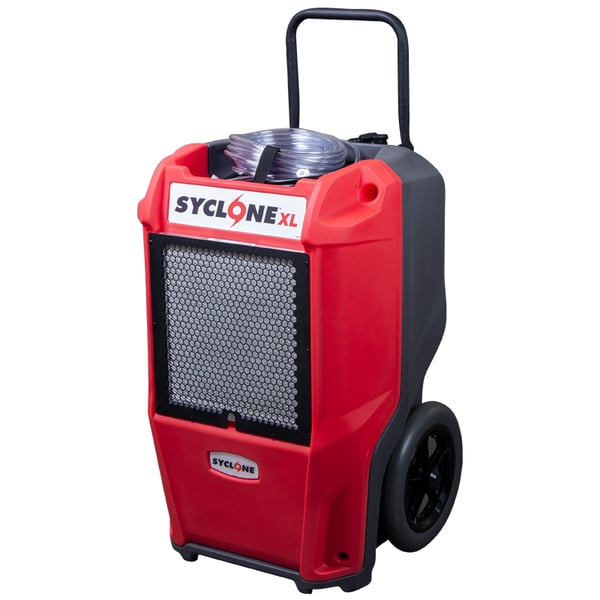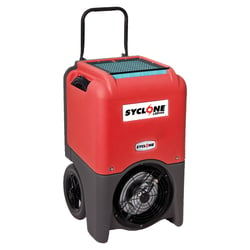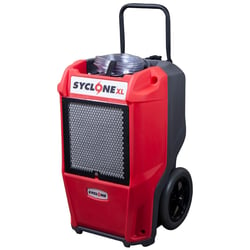Dehumidifiers have come a long way since the early days of drying. Manufacturers are continually working to improve drying capabilities and engineering equipment that can squeeze out the maximum number of pints of water at AHAM. As a result, we now have dehumidifiers that are ergonomically friendly, have automatic features, and can even connect to Bluetooth.
But all of these features can only tell you so much about which dehumidifier you should pick for your business. Every business is unique, and you should always consider your needs first before making an investment in your equipment.
This article will break down the business needs that you should address when selecting between these two dehumidifiers.
General Questions to Consider When Selecting a Dehumidifier
I've written before about the 5 questions that you should ask when buying a dehumidifier, and I'm reposting these here to start our discussion:
1. Which dehumidifier is right for your job?
Every flooded home is different.
The temperature of the house will vary, the amount of power that you have to work with will change, and the size of the space that you are working in will vary.
Despite this, you should be able to reference typical conditions that you will be operating in so that you have an idea of what equipment most jobs in the area will require. This will help you to narrow down your selection of equipment.
2. How functional and mobile will the equipment be on its way to, from, and at the job site?
“I would avoid dehumidifiers that are difficult to handle. They need to be able to be mobile, and hopefully, one person can maneuver them to set them up at a job. Are they stackable? Because that’s going to take up less room in your vehicle,” Rachel Adams, a restoration expert advises.
You'll want to ask yourself questions like this before you’re at the job site so that you don’t have to lug heavy equipment up the stairs.
By choosing equipment that is easier to maneuver you will make life easier on yourself and your technicians and save time when you are out in the field.
3. Do you have the proper equipment to use with your dehumidifier?
Dehumidifiers are built to remove moisture from the air. They are not evaporation machines.
When the air is hot and wet you will draw more moisture from the surrounding environment.
You want to use other equipment like an E-TES or an air mover to increase evaporation in the room that you are working in. These technologies can be used to manipulate the environment and create optimal operating conditions for the dehumidifier so that it can take water out of the air.

4. What are the Operating Conditions you will encounter in the field?
Performance in Drier Conditions-
The AHAM (Association of Home Appliance Manufacturers) rating of your dehumidifier doesn’t always translate to a real-world job.
These ratings only tell half of the story of what your machine is capable of because AHAM ratings are the manufacturer’s measurement of how many pints of water are removed when operating at conditions of 80 degrees Fahrenheit and 60 percent humidity.
Real-life conditions are never as straightforward as the AHAM test conditions because temperatures and operating conditions on the job will change once you get past the first day of drying and have removed the water that is easy to extract.
Knowing this, you will want to have a product that also performs well in drier conditions (when the air consists of fewer grains of water per pound).
To ensure this, talk to your manufacturer.
They can let you know if your dehumidifier will still be able to work at the lower ranges.
You can also ask them to give you the AHAM ratings at drier conditions before choosing to buy the unit.
Amperage
A lot of manufacturers try to make the Amperage as low as possible and that’s for two reasons:
- They are trying to get as much water removal per amp as they can
- They are also trying to make it so that you can use more dehumidifiers on the job.
You want to be able to use as many units as you can but also make sure that the circuit can handle everything that’s plugged in. Putting more equipment on a circuit is ideal because electricity is at a premium.
When choosing a dehumidifier ask yourself: how many pints of water removal am I able to achieve per AMP?
5. Have I standardized my equipment?
Today’s manufacturers offer so many different products. With so many choices you need to be careful that you are choosing correctly.
If you are on the job and need technical help it’s better for you to stick to the same make and model of equipment.
“I like to stick with one manufacturer, that way I’m doing the volume of my work with them. That way if I have a problem I can always call them and say: hey this is what happened,” explained another restoration expert.
“My point is getting to know someone there--either a vendor or distributor that I can call all the time and say ‘I have this question that needs to be answered,’ and then also having the same pieces of equipment.”
Choosing the same SKU also makes your life much easier at the job site because you will have a lot fewer moving pieces to address.
“I wouldn’t mix them up for a few reasons. One is for when I call into technical support to talk about how they are working, but also it helps with training with my technicians as well,” they explain.
“If you’re using the same unit, whether it’s at Ms. Jones or Ms. Smith’s, and you don’t have to stop and think and recalculate that this is Machine A and this is Machine B, then this makes training and support easier.”
Don’t forget that you will also need to replace the filters inside your dehumidifiers and maintain them on a regular basis. It is not uncommon for dehumidifiers to require different parts. By selecting the same ones you won’t have to worry about keeping an excessive number of replacement filters and maintenance parts in your inventory.
“Find a unit that works well for you, a manufacturer, a model that you like, and make the bulk of your products that unit,” the expert explains.

Applying these Questions to the Syclone 145 LGR and Syclone XL LGR
Let's use the framework of the 5 questions above to compare the Syclone 145 LGR and Syclone XL LGR.
1. Which dehumidifier is right for your job?
Is one area or condition more specific/right for one dehumidifier versus another one?
Price Per Pint and Price Per Amperage:
Both the Syclone 145 LGR and Syclone XL LGR are in the XL Dehumidifier category for Xactimate pricing based on pints per day (PPD) of water removal at the manufacturer's AHAM rating. However, the Syclone XL LGR is at the lower end of the range (125 PPD), whereas the Syclone 145 LGR is at the higher end (145 PPD).
Some contractors will use the comparison of how much the dehumidifier costs per every pint removed (price $/pint) to compare units.
At the time of writing, according to our current list price, the calculations are as follows:
Syclone 145 LGR = $2,981/145 PPD = $20.56/Pint.
Syclone XL LGR = $2,831/125 PPD = $22.65/Pint.*
*Remember that this calculation only holds for AHAM (80 degrees/60 percent relative humidity). There isn't a manufacturer's standard for lower relative humidity as the job progresses and you reach low grain conditions.
Some contractors also like to perform the same calculation for Amperage:
Syclone 145 LGR= $2,981/9.8 AMPs= $304 per every AMP drawn.
Syclone XL LGR= $2,831/8 AMPS= $309 per every AMP drawn.
CFM
The 145 LGR has 280 CFM and the XL LGR has 320 CFM. This doesn't really matter though because you should focus on the amount of water output (discussed above). The AHAM rating is more important when determining the pints per day removed. If you want a more accurate estimate of how much water the machine will remove in drier conditions, you should ask your salesperson to give you these ratings before choosing which unit to buy.
As you can see from this comparison, the Syclone 145 LGR is a better value, and you can dry faster with this unit. However, the Syclone XL LGR draws a lower amount of AMPs, so you can put more on a job and charge the same price because both dehumidifiers are in the same category. Technically, you will need more Syclone XL LGRs to dry a house in the same amount of time given the same conditions.
2. How functional and mobile will the equipment be on its way to, from, and at the job site?
Both the Syclone 145 LGR and Syclone XL LGR are ergonomically designed. The 145 is nine pounds heavier (115 pounds) than the XL LGR (106 pounds). This might not make much of a difference depending on your business, but it should be seriously considered. If you have technicians that aren't as strong, you might want the smaller unit. Additionally, a nine-pound difference can add up when you have to account for storage size, especially if you have dozens of units; every pound starts to add up.
Both units can be wheeled into the job and have handles so that you can load them onto your truck. This feature makes them easy to transport. Each unit has built-in technology, called the Command Hub, that enables you to monitor them from a distance.
3. Do you have the proper equipment to use with your dehumidifier?
Even after deciding between these two dehumidifiers, you still need equipment that will complement them in the drying process. Successful drying begins with extracting as much water as possible before leveraging the science of evaporation or dehumidification. Removing liquid water through extraction (i.e. water claw, or portable) is at least 500 times more efficient than removing water by using a dehumidifier or air mover.
Once you have finished extracting as much water as possible, make sure to pick the right air mover and/or an E-TES to create an optimal drying ecosystem. As an air mover blows across the surface of wet objects it dries the wet material and the water molecules evaporate into the air, becoming water vapor. You need to have the optimal ratio of air movers to dehumidifiers, to ensure that the surrounding air doesn't become saturated with water vapor, at which point no further evaporation can occur.
Make sure to take all necessary readings so that you can keep track of how the job is progressing and for documentation purposes for the insurance company.
4. What are the Operating Conditions you will Encounter in the Field?
Both machines should be used for larger drying jobs. Because both machines are in the same category the amount of water that they remove at AHAM is relatively close. The Syclone 145 LGR and Syclone XL LGR are workhorses of the industry. If you are doing mostly large flood jobs, you want to use these dehumidifiers. If you are doing a smaller job, you will need to use a large unit as this is the type of dehumidifier that you can charge insurance companies. You want to size your dehumidifier to the job that you are doing.
5. Have I standardized my equipment?
Both dehumidifiers have their own proprietary filters. Filters should be changed often, preferably after every job, and this can usually be charged off as an expense.
In terms of maintenance, the Syclone XL LGR is a little bit easier to maintain. There are only four bolts that need to be removed to reach the guts of the machine. Contractors should take the machine apart to clean the fins on the radiator or to clean the pump-out if excessive dust has accumulated. You want to maintain the pump out regularly to ensure that the pump-out is working optimally. You also want to keep the coils clean so that airflow can move smoothly and deliver 100 percent performance. If anything is blocked then performance will suffer.
Miscellaneous Considerations
- The Syclone XL LGR has extreme dewpoint technology. This is an optimal sensor technology that responds to the conditions going on to speed up or slow down the airflow. This optimizes the capture of water.
- At 53 average decibels of operating noise, the Syclone XL LGR versus 65 average decibels of operating noise for the Syclone 145 LGR, the XL is the quieter unit. Homeowners hate noisy equipment, and this can cause a headache for contractors if they grow irritated and decide to unplug the equipment. The lower decibel Syclone XL LGR is a better machine when considering noise.
- The Syclone 145 LGR has a built-in humidistat. The humidistat allows you to set the humidity to the level that you want. This is a good feature to have if you finish a job and an HVAC system isn't present in a home. You can leave the dehumidifier at a finished job and use the humidistat feature to control the environment and prevent mold growth in areas like a basement or an indoor pool until a house is finished being repaired.
Conclusion
The Syclone 145 LGR and Syclone XL LGR are both great units. You truly have to consider the unique needs of your business before determining which unit is right for you. Which conditions will you encounter while drying? Do you care more about size or weight? Do you want a unit that dries faster? Do you want the humidistat feature? Do you want a quieter unit? Once you have the answer to these questions, you will know which unit is right for your company.
Make sure to reach out in the comments if you have any questions!
Special thanks to Ron Colling for providing research and guidance on this article.
Subscribe to Pro's Corner Blog
Featured Products


Syclone Dehumidifier with Filter XL LGR
